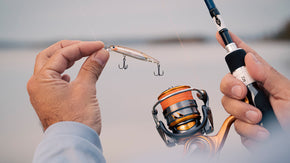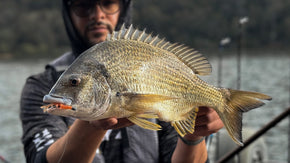Posted 21th August 2025
Beginners guide to baitcasters


By Robert Thornton
Baitcaster reels have been part of sportfishing for over a hundred years, and over the course of a century they have become a key part of many angers’ kit. It’s true that baitcasters are incredibly versatile tools, and in the right circumstances can offer clear advantages over spin tackle.
Despite this, a lot of people still shy away from them, largely thanks to an old belief that they are fiddly, flighty and overly complicated compared to a good old eggbeater or spin reel. While this is partly true – certainly in past decades – baitcaster technology has advanced to the point where they are far more user-friendly and accessible for the beginner. Basically, the problems that plagued the budding baitcaster user of yesteryear can be mitigated by leveraging the science that goes into each one on the production line.
Popularity of baitcasters has waxed and waned through the years, however with the current rediscovery of ultra-light baitcast tackle and reel technology reaching an absurd level, there has never been a better time to give them a go.
In this beginners guide to baitcasters, we’ll look at what baitcasters can offer, how to choose a baitcaster reel, how to set them up, and finally how them.

ALL ABOUT CONTROL
Baitcasters have changed significantly since they first became mainstream fishing tackle almost a century ago. Early models were cumbersome lumps of metal, often with a 1:1 retrieve ratio and required two hands to use. These days, round-sided metal designs have been largely replaced by compact, low-profile models with ball-bearings and brakes with, and come in ergonomic shapes to aid one-handed casting. With that said, recently there has been a renewed interest in baitcasters with the ‘retro’ round-sided look.
While the appearance and internal mechanisms of old and new models are like chalk and cheese, they have always offered a few attractive features for the user.
First and foremost is the control and feedback. Control refers to the option to ‘feather’ the spool with the thumb when casting, resulting in better accuracy and judgement. Baitcasters also provide superior control when fighting fish in tight cover, with users able to apply more stopping power, once again, by putting the thumb on the spool! Feedback comes in the retrieval stage, with baitcasters allowing anglers to better feel what’s happening on the end of their line. Baitcasters give better feedback because of the direct contact the retrieved line makes with the spool as it’s wound on, as opposed to on a spin reel, where the line must go into a line roller and turning 90 degrees before being spun onto the spool.
CHOOSING A BAITCASTER
When picking out a suitable baitcaster, it’s important to think about the sort of fishing

you’re doing. For example, if you’re someone who mostly chases bass or yellowbelly in the freshwater, you’d opt for something small and compact that allows for fine-tuning of the cast control. Daiwa’s Tatula Bait Finesse (BF)or 24 Steez are great choices for light tackle lure casting in freshwater.
On the other hand, if you’re chasing mangrove jack, barramundi and other estuary brawlers in the salt, something larger and more heavy-duty is a better pick. The Tatulion HD Custom or Tatula 200 are both designed for harsh saltwater environments and have large gears to turn the heads on trophy fish.
Good-quality baitcasters generally have a spool tensioner and a cast control, also known as a brake. The spool tension can usually be adjusted by tightening or loosening a knob, while the cast control – depending on the technology – is adjusted according to design. Cast controls are mostly either magnetic or centrifugal, and their main function is to control the rate of line coming off the reel when casting, which in turn mitigates tangles, overruns and backlashes. In simple terms, the tensioner adjusts the resistance of the free-spinning spool overall, whereas the cast control kicks in once a cast is made and applies extra resistance in flight.
Cheaper reels often only have a spool tensioner and no cast control, and sometimes they don’t have either. If you’re serious about getting into baitcasting, you’ll want your reel to have both features, as this will allow you to tune it up to get optimal performance with whatever rod, line and lure you’re using.
Of course, the baitcaster you choose should feel balanced and ergonomic on the rod it’s paired with. I recommend any first-time baitcaster buyers feel both rod and reel as a unit before making a final decision.

SETTING UP YOUR BAITCASTER REEL
Once you’ve got your little contraption, it’s time to set it up! If you’re buying from a tackle store that includes line spooling as a service, I recommend that option. Working at a tackle store, I can tell you that we spool dozens of reels each week and know how to set them up right.
If you decide to set it up yourself though, there’s a few little things to keep in mind. Firstly, if using braid as your mainline, always put down backing monofilament first. Backing will prevent the spool knot from spinning and ensure the braid has something to ‘bite’ on once spooling begins. Even with shallow spool designs that can’t take much line, a few inches of backing will ensure your braid goes on nice and tight rather than loose and prone to spinning.
When spooling begins, make sure the braid goes on under tension. Even with very light braid, you want to ensure enough tension so that the loaded spool feels hard, and not spongey like a miniature bird’s nest. If not, braid coming off your reel will start digging into the braid on the spool when under load, and can cause tangles, breakages, and negatively affect casting.
Equally important is not to overfill the reel. Baitcasters generally don’t take as much line as similarly sized spin reels, and sometimes 50-60m is all you’ll get on there. Don’t worry if you can’t get much on– most baitcasting is short-range fishing where accuracy and power take priority over distance and speed.
The line should never go any higher than the free-spinning spool. If overfilled, the braid can hit the housing around the spool, impacting retrieval and casting. Another problem can arise when the line slips off the top of the spools and into the gap between the top of the spool and the main body of the reel, which again impacts casting and retrieving.

HOW TO USE A BAITCASTER
Now your reel has line, it’s time to use it! For baitcaster newbies, I can’t recommend practising your casting enough. Down at spot X when the hot bite starts is not the time for learning, as baitcasters can take a bit of getting used to.
First things first, you’ll need some space – at least 10-15m to throw a cast and preferably no overhead obstructions like trees, powerlines or anything else. If your yard isn’t big enough, a local park or other strip of public land will do.
Second, you’ll need something to cast, ideally something similar in weight and size to the lures you intend to eventually throw with it, and obviously without any hooks. Casting plugs designed for this very purpose are excellent, however small sinkers or lures with the hooks taken off work well too.
Once your casting weight is tied on, you’ll need to set up your spool tension and cast control. Starting with the tensioner, tighten it up to the point where line doesn’t come off the reel when in free-spool, and gradually loosen it until your weight just starts falling toward the ground. A good rule of thumb is to loosen it to the point where the casting weight just starts to fall and the spool stops spinning once it hits the ground.
Next is the cast control, usually a dial on the opposite side of the reel to the tension knob, where 0 is no brake, with higher numbers providing incremental levels of brake. I recommend you start with a higher brake, and once comfortable you can begin gradually dialling it back. Skilled casters will often use next to no brake, relying almost solely on their thumb to control the rate of line coming off the spool.
Should you get an overrun or backlash, often called a bird’s nest (inevitably it will happen), they can be fixed most of the time. The trick it to pick at the knots on the spool, loosening them up enough for you to manually pull some line off the reel until the knots are gone. Once the backlash is cleared, wind the loose line back onto the spool under tension – I like to use my non-winding thumb and forefinger for this.
Practise is the key with baitcasters, and once you’ve got the basics down you can start experimenting with different casting techniques and even try hitting targets. It might all feel a bit fiddly at first, but trust me, it will become second nature soon enough!
BAITCASTER BEGINNINGS
Baitcasters sometimes get a bad wrap, but in truth they are a tool that can enhance your fishing if set up and utilised correctly. The ‘BFS’ (bait finesse system) revolution in recent years has seen a renewed appreciation for these awesome little machines, so now is a great time to dip your toe in.
If you’re thinking about getting into the world of baitcasters, do yourself a favour and just give it a go! You’ll soon understand why some anglers prefer them over other reels.

How to Set Up a Baitcaster- Daiwa Tech Tips















